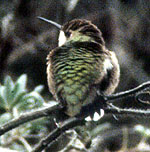 the
only other image I have of the same bird.
the
only other image I have of the same bird.
Here is  the
only other image I have of the same bird.
the
only other image I have of the same bird.
Paul Conover sent the following interesting comments:
unfortunately, the resolution isn't very good on the hummer shot. are there other photos? it's an interesting bird which surely does make me think rthu. back color and bill length look so good for that, but those aren't hard and fast features. as far as solid clues on what to look for, i rely on the info in baltosser's outstanding paper.
the difference in the shape of primary 10 is what i key in on in the field. not only is the shape of p10 different, but the overall shape of the wingtip is affected, giving it a more rounded, blunt look on bchu. if there are other pictures of this bird, perhaps the wingtip is visible. even a silhouette shot of the tip would be a good indicator.
primary shape is the best feature that i know for in-field determination. i use telephoto to id them generally, and that's usually easy to see with optics. i don't band hummers, so i'd have to think about other small differences. i do know that rthu usually has notched, irregularly shaped inner primary tips, vs blunt tips on bchu, but i don't think that can be determined from a shot like this.
i mentioned before that it appears to be a female, as the white tip on r3 seems too large for an imm male. the bill appears short for a female bchu, but as there's overlap in that measurement, it could just be the small extreme for bchu.
again, the opinions of newfield, sargent and patton would be more valuable than mine.btw, all of the features i mentioned are visible in the rthu and bchu pages on my site http://www.talstar.com/users/conover/ be sure to look at the pictures showing the back colors of the 2 species---it also shows the differences in the inner primary shapes of the two species pretty well.
Earlier Paul had commented:
usually the wingtip shape and size is a clincher for species, but a few weeks ago i had an archilochus in tallahassee that seemed borderline. also, its back was a glittery green like rthu. i felt it was an adult female bchu that looked a lot like a rthu. i also felt like i was a wimp for not being able to call it with certainty, until i talked with dave patton and he told me about some archilochus he banded in la this winter that were borderline even in hand, with flight feather shapes that seemed intermediate between rthu and bchu. i believe he left them as archilochus sp. i felt better after hearing that! ....
The warbler is actually rather infamous in California's birding history. Albert Ghiorso was attempting to photograph a Black-throated Blue Warbler when this bird hopped into his view finder. He never saw the bird through binoculars and thought nothing of it at the time. But when the photograph came back from the lab, it looked suspiciously like a Connecticut Warbler. I viewed the photo and agreed. We sent the slide to the California Bird Records Committee where it nearly passed on the first circulation. However Laurie Binford recognized that the bird was actually a Yellow Warbler and the record was never accepted. Partly because of this near fiasco, the committee has been extremely wary of documentation that consists of only a single photograph withou additional description. Photos can be very misleading!
The image has been enlarged and cropped for display here. But the original slide is a much smaller image and much less detail is visible unless it is viewed with a strong lens. Here it is much easier to see the yellow tail spots, dark inner webs to the tertials, whitish belly and darkish tarsus; all of which are wrong for Connectucut Warbler. The first two characters also eliminate Nashville Warbler.
Paul Conover commented that "the warbler is a dead ringer for the yellow in the photo quiz of
birding [v.XXI no.5]."
The original mystery photos are below.
| Can this hummingbird photographed in California be identified? Click on image to view full size. | Here's a warbler photographed at Point Reyes 6 October 1977 contributed by Albert Ghiorso. Click on image to view full size. |
What do you think these birds are? Please click here to view comments or add your own. Thank you very much for contributing your thoughts.